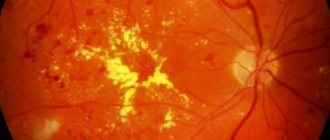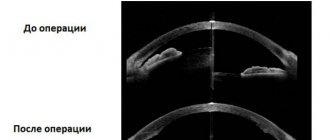Astigmatism is a pathological condition characterized by refractive error and manifests itself as a visual disorder.
Normally, light rays reflected from objects in the field of view, when passing through the structures of the eye, are focused at one point. In this case, an inverted image is projected onto the retina.
However, if the ocular structures are disturbed or irregular in shape, there is a lack of focusing of light rays at a certain point and its scattering.
Changing the shape of the cornea leads to unnatural refraction of light rays, which is manifested by visual impairment, or rather distortion of objects or clouding of the image.
Mixed astigmatism is not as common as other types of this pathology (up to 9%). The condition is characterized by both myopic and hypermitripic refraction of the cornea in different meridians.
Those. in the horizontal and vertical meridians, different image focusing positions are observed - in front of and behind the retina. Because of this, the image is significantly blurry and it is impossible to fully focus on a specific object.
Causes of mixed astigmatism
Mixed astigmatism in children is often congenital in nature and is formed due to heredity. If the disease occurs in parents or close relatives, then there is more than a 30% chance that the baby will develop this pathology. In this case, the disease manifests itself as curvature of the cornea of the eye organ. Mixed astigmatism of both eyes in children is often accompanied by strabismus. Such deviations can affect the baby’s mental development, since all surrounding objects are visible to him indistinctly and blurry. Therefore, early diagnosis and correction of pathology plays an important role for the child.
Mixed astigmatism can also be acquired. Pathology is formed due to corneal dystrophy, as well as if a scar begins to form in its structure. The following factors can provoke this:
- eye injury;
- previous surgical interventions on the eye organ;
- the presence of infectious diseases of the cornea in the form of herpetic keratitis.
Important: Sometimes pathology can form in the presence of keratoconus disease. This is a degenerative disease of the eye organ that leads to dystrophy and thinning of the cornea.
Symptoms of the disease
Incorrect refraction of light in the eye with myopia and farsightedness leads to blurring of objects, astigmatism changes their shape, they bifurcate and stretch, the boundaries are also blurred. A person does not see clearly either near or far.
In cases of mild mixed astigmatism, eye fatigue may occur. A person can get used to a distorted vision and not notice it. With more pronounced changes, headaches, pain, and lacrimation occur. Objects split into two and the ability to concentrate decreases. The patient begins to squint and tilt his head. Even dizziness is possible.
The image constantly appears as in the mirrors of a funhouse, which causes headaches, a feeling of rapid eye fatigue, and a feeling of helplessness due to the impossibility of correct orientation among the curvature of the universe.
Symptoms
One of the main symptoms of mixed astigmatism is visual disturbances. For a patient with this pathology, all objects are visible blurry; he cannot determine the exact distance to them, as well as their sizes. In this case, it does not matter at what distance the object in question will be located. These disorders are accompanied by other pathological signs such as:
- rapid eye fatigue;
- the object in question can be split into two;
- frequent pain in the forehead;
- frequent irritability appears;
- There may be dizziness.
Not all children can describe how they feel. If parents do not pay attention to the baby’s changed behavior, the disease can have serious consequences. What should parents pay attention to?
- the baby often begins to squint when looking at an object;
- the child’s refusal to write, read or draw;
- manifestations of irritability and tearfulness;
- lag in studies.
Important: This disease has one more feature. A child may not see large print, but it is easy to read small print.
The manifestation of any of the above symptoms should be a reason to contact an ophthalmologist for advice.
Prevention
Here's what you can do to prevent pathology:
- It is necessary to undergo annual examinations with an ophthalmologist;
- if you have previously diagnosed myopia or farsightedness, you need to use glasses or contact lenses;
- when working at a computer for a long time, it is recommended to take a break every 45-50 minutes and give your eyes a rest, for example, doing special exercises;
- The diet should be varied, rich in foods high in vitamin A.
To prevent congenital astigmatism in a child, a woman should carefully monitor her well-being during pregnancy: spend a lot of time in the fresh air, take vitamins, and undergo all necessary examinations.
Author of the article: Elizaveta Viktorovna Klokova, specialist for the website glazalik.ru Share your experience and opinion in the comments.
What is the risk of mixed astigmatism for a child without timely treatment?
The most serious complication is the formation of amblyopia - lazy eye syndrome. The reason for the formation of this disease is that light rays penetrating the eye organ cannot focus on the retina, but the eye continues to see. Everything seen is transmitted to the part of the brain responsible for vision. The brain begins to process the received visual information, but much depends on the quality of the resulting visual image. The resulting unclear picture leads to the fact that the corresponding cells first lag behind in development, and then stop developing altogether. Visual signals are no longer processed, and this provokes a decrease in the quality of vision.
This disease is treated with the use of special glasses, where one lens does not allow the eye that does not have visual abnormalities to see. The child has to look through the eye organ with poor vision. This stimulates the organ, and visual acuity begins to develop. These glasses need to be worn for a couple of hours a day (daily). In the form of auxiliary therapy, experts recommend treatment with special devices that, using a laser beam or light, act on the retina of the eye, stimulating it.
Important: If it is not possible to purchase special glasses for the treatment of amblyopia, you can use regular ones. To do this, the glass on the side of the healthy eye is sealed.
An equally common complication of mixed astigmatism is the development of strabismus, which entails other difficulties for the child. A large set of complexes will affect the entire subsequent life of the baby.
Reasons for development
Despite the fact that the pathology has been studied for decades, the etiology of the disease still remains vague. Experts classify mixed astigmatism as a genetically determined pathology that is inherited by a child through an autosomal dominant type. But the disease in some cases can occur in patients with an uncomplicated family history.
Common causes of mixed astigmatism:
- Keratitis . An inflammatory process occurring in the cornea. Involves the formation of stromal or subepithelial opacities on the surface of the organ. It is the presence of such changes that leads to violations of refractive indices.
- Heredity . The most common cause of pathology. If one or both parents have visual impairment (or astigmatism itself), then the child is likely to inherit the problem.
- Injuries. Post-traumatic astigmatism is formed only if the patient has received a penetrating corneal injury. Erosive changes are more favorable in terms of prognosis, since as the erosion progresses, the degree of the cylindrical component of refraction also decreases.
- Unfavorable surgery. Improperly performed microsurgical interventions (for example, removal of pterygium, penetrating or layered keratoplasty, etc.) can cause the formation of defects and the development of a mixed type of pathology.
Treatment of mixed astigmatism with glasses and lenses
Impaired vision with mixed astigmatism is corrected using lenses or glasses. This method will not fix the problem itself. Curvature of the cornea can only be corrected through surgery, which is carried out in two ways (we will consider further).
For mixed astigmatism, special glasses with spherocylindrical shapes are made. In this case, the following individualities are taken into account - refraction in the meridian with myopia (myopia) decreases, the meridian with farsightedness (hyperopia) enhances it.
For adults, wearing such glasses will be a requirement. The specialist will determine the wearing mode depending on the degree of pathology (glasses may be prescribed for reading only). But the child will need constant wearing. This is due to the fact that the child’s eye organ continues to grow and develop. To avoid any disturbances in these processes, visual acuity must be constantly corrected.
Modern ophthalmology offers a more convenient way to correct vision with mixed astigmatism - complex contact lenses of soft and hard structure. Compared to glasses, they have many advantages. Among the main ones:
- The contact lens fits more tightly to the cornea. This makes it possible to minimize optical errors.
- When wearing lenses, discomfort is minimized. The patient may not limit his activity. There is no risk of breakage, falling out or loss.
- Lenses for vision correction for astigmatism are made taking into account all the individual characteristics of the patient’s eye organ, therefore their ability to correct is significantly increased in comparison with glasses.
- When wearing glasses, the patient has errors in the image with lateral vision. Due to the fact that the lenses have close contact with the eye organ, the patient is not bothered by such problems.
Important: The effectiveness of contact lenses and glasses must be checked every six months. For these purposes, they undergo computer diagnostics and visit an ophthalmologist. The slightest changes in visual acuity require changing lenses or glasses.
For small children, the option of contact lenses is unacceptable. A specialist can advise this type of correction only after the patient can independently cope with the installation and removal of the lens.
Diagnostics
The initial examination of patients includes collecting general information, including complaints about certain deviations from the patient, examining the visual organs, and conducting simple tests. The ophthalmologist will evaluate the position and mobility of the visual organs. But the results of examinations using special devices will play a decisive role in establishing the final diagnosis.
Mixed astigmatism is diagnosed using the following techniques:
- Visometry . Testing of visual functions at a distance, near and at a working distance is carried out with correction and a specialized diaphragm.
- Retinoscopy . Used to study the patient’s objective refractive ability and select the appropriate therapeutic method. The advantage of this diagnostic method is that it is informative in the case of young patients, since the final data does not depend on the patient’s reaction.
- Computer autorefractometry. It is carried out during the initial diagnosis of the patient. Helps obtain information about subjective refraction. Based on the data obtained, a trial correction is selected that allows you to restore visual functionality.
Treatment of mixed astigmatism through surgery
Surgical intervention allows you to completely get rid of the problem of mixed astigmatism, but procedures are prescribed only in the absence of any pathologies in the retina. Also, surgical intervention cannot be performed if there are ophthalmological diseases or scars located on the eyeball.
In total, 2 main methods of surgical intervention are practiced. Keratotomy – A specialist applies micro-incisions to certain areas of the cornea of the eye organ, which helps to change its curvature. The method has many disadvantages. The main ones are low efficiency, a long postoperative period with regular pain.
Laser correction is more effective. Incisions are made with a special device, then the middle layers of the cornea are exposed to a laser beam. This allows you to give the cornea the correct shape. The optical power in the required meridian begins to increase, and in another it decreases.
The prognosis for this treatment is favorable. The following will help speed up recovery: proper nutrition, a combination of stress on the eye organ and special gymnastics. The attending physician will inform you about all the features after the operation.
Sources used:
- Vodovozov, A.M. Study of the fundus of the eye in transformed light / A.M. Vodovozov. - M.: Medicine, 1986.
- Volkov, V.V. Combined eye lesions / V.V. Volkov, V.G. Shilyaev. - M.: Medicine, 1976.
- Vision. Preservation, normalization, restoration: monograph. . - Moscow: Higher School, 1997.
- University of Edinburgh
To treat or not?
Correction of refractive error is based on increasing the optical power of the eye in one meridian, and in the second, perpendicular, it decreases. The earlier it is identified and correct correction begins, the higher the effectiveness in reducing the progression and stopping the disease.
The following methods are used to correct mixed astigmatism:
- conservative (glasses, contacts);
- surgical (astigmatic keratomy, laser).
In childhood, due to the undeveloped visual system, measures to correct the disorder have a narrow scope. But treatment needs to start as early as possible - the absence of full or partial correction before 10 years can lead to significant visual impairment.
Glasses
At this age, the easiest way to treat is glasses. They eliminate the difference in refraction between the vertical and horizontal optical axes. But glasses have disadvantages: it takes a long time for the eyes to get used to them, difficulties in selection, lack of lateral vision, are not suitable for active activities, and do not fully correct refractive error.
Lenses
Corrective lenses (toric) do not have these disadvantages, however, they are not recommended for use in children. This is due to the complexity of their installation and the possibility of damaging the child’s eyes. In older age, toric lenses are a modern, convenient way to eliminate the defect.
Surgery
Please note that surgical methods for correcting refractive error cannot be performed before the age of 18-20, except in emergency cases.
In adults, astigmatic keratomy is used. This is an operation in which incisions are made on the cornea to change its shape. This method does not always solve the problem; it has side effects and a long rehabilitation period.
Laser
The use of a laser is the most effective way to correct a refractive error. In one meridian, the optical power is increased by removing tissue from the outer layer of the cornea, and in the other, tissue is removed from the central part. The advantages of laser correction are short manipulation time and quick eye recovery time.
If correction using these methods fails, the ophthalmologist may recommend more radical interventions: corneal transplant, intraocular lens, lens replacement.











